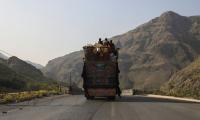More than 128 million voters will elect 266 members to the National Assembly and 593 members to provincial assemblies on February 8.
A majority of the voters who want to cast their ballots in the elections have already decided whom to vote for. But there are still thousands of voters in each constituency who have not yet made up their minds. Political parties will focus on these voters during the election campaign.
One can easily divide these voters into three categories. The first one consists of those voters who have strong political affiliations. These voters form the core base of a political party. The PTI and the PML-N have their core support base intact in Punjab. The PTI is still popular with people from the middle class and among young voters.
The PML-N has been able to regain much of the ground it lost while in the 16-month-long coalition government. The arrival of its supreme leader and former prime minister Nawaz Sharif has significantly helped the party gain its lost popularity.
In many urban constituencies, the PTI and the PML-N are going neck to neck. In these constituencies, swing or independent voters are going to play a decisive role. The parties that will successfully attract a majority of independent voters are likely to win from these constituencies.
The PPP has gradually lost much of its core support base in Punjab since 2008. They are vocal voters of their parties and also try to influence swing voters. In urban constituencies, a majority of voters are politically affiliated so the contest can be tough.
The second category consists of voters who have no strong political affiliation and are known for changing political loyalties before every election. They are called swing or independent voters.
The term ‘independent or swing voter’ means someone who is not politically affiliated with any political party. These kinds of voters go into elections without preconceived ideas about which party to vote for and instead consider the merits of each candidate and party in every new election.
The third category consists of absent voters. These voters hardly bother to cast their ballot on Election Day. In Pakistan, around 50 percent of voters are absent voters – the average turnout of elections is 42 per cent. The turnout was higher than the average in the 2013 and 2018 elections. It was 51 per cent in 2018 and 53 per cent in 2013.
It is not yet clear how many voters will cast their ballots in the upcoming elections. The extremely cold weather and the worsening law and order situation in some parts of the country might affect the turnout in the February elections.
A majority of absent or no-show voters are young voters. In the 2018 elections, only 30 per cent of young voters went to the polling stations. Young voters between the ages of 18 and 35 years are nearly 45 per cent of the total electorate of 128 million voters. Political parties are not making serious efforts to attract and mobilize young voters. No political party can take these voters for granted.
Independent voters are diversified and divided as far as their political, social and religious views are concerned. They are divided not only on rural and urban lines but also based on class. For example, a single issue may attract only middle-class independent voters, but not necessarily independent voters belonging to the working class. Financial incentives, social pressures and strong-arm tactics come into play to attract poor voters.
Different opinion polls in many constituencies currently suggest a close contest between the PML-N and PTI in the battleground – Punjab. A neck-to-neck fight is expected in the province’s urban constituencies while the PML-N has an edge over the PTI in rural constituencies.
In a closely contested election, independent or swing voters play an important role in the outcome. There are at least 15-20 per cent swing voters on average in every constituency. Swing voters become a crucial factor in the outcome of closely contested constituencies.
Many independent voters go along the wave. Social media, mainstream media and election campaigns play an important role in opinion-making. In the 2013 elections, a majority of independent voters went for the PML-N, and in 2018, they chose the PTI; the section of more religious voters went for the TLP. Many people who voted for Imran Khan did so because they wanted to give him a chance to prove his claims of reforming the government. Statements like ‘give Imran Khan a chance and try him this time’ were dominant in that section of independent voters.
But the situation seems different in this election. The dispute around the election symbol of the PTI is still not settled, and the legal battle is still going on. The PTI might be forced to contest elections without its election symbol – the ‘bat’. This may disappoint some PTI voters who are likely to opt not to vote. So the situation is not yet clear.
There is hardly any enthusiasm among big sections of independent voters about the upcoming elections. The sections of poor and working-class voters have lost confidence in the political leadership and strongly believe that political leaders are not keen to address their issues. Soaring prices, high unemployment and rising poverty have disappointed many working-class and poor voters.
In a close election, two factors become decisive. One is the importance and the role independent or undecided voters play, and the other is the maximum mobilization of a party’s support base.
All the major political parties have their core support intact in their respective strongholds. The real battle for them will be to attract and mobilize swing voters in their favour. The parties will have to work hard to mobilize these voters.
The writer is a freelance journalist.
Critics argue that strategy is vague, but closer look indicates strategic alignment with global trends and national...
To defeat it, we must distrust bot-driven narratives, to defeat it, we must verify sources before believing or sharing
Too often in emerging markets, digital innovation is treated as standalone goal, with risk relegated to afterthought
As in Pakistan lawfare’s impact and prevalence are increasing, situation is turning murkier
Number of traditions are associated with Eid, such as new clothes and giving and receiving of cash gifts as Eidi
Internationally, there have been misleading theories propounded about so-called slowing of Chinese economy







